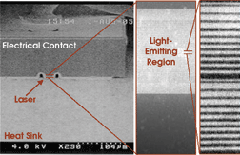Daniel S. Burgess
As part of the Laser Photoacoustic Spectroscopy program funded by the Defense Advanced Research Projects Agency, researchers at Northwestern University in Evanston, Ill., have demonstrated quantum cascade lasers that produce 106 mW of CW 9.5-µm radiation at 298 K. The work supports efforts to develop a man-portable system for the US military that will detect the presence of explosives and chemical warfare agents by their spectral signatures in the 4- to 12-µm region.

Quantum cascade lasers developed at Northwestern University have produced more than 100 mW of CW 9.5-µm radiation at room temperature, suggesting their potential as sources for portable spectroscopy systems. From left to right, the electron microscopy images display a laser bar bonded to a heat sink, the relative size of the emitting region and the atomic-scale layer structure of the device. Courtesy of Manijeh Razeghi.
Since they were first reported in 1994, quantum cascade lasers have been of particular interest as illumination sources for spectroscopy because they operate at mid- to far-IR wavelengths, where molecular signatures are particularly strong. Electrons in these lasers emit photons as they tunnel successively through the barriers between a series of quantum wells in the device structure. Transition energies are determined by the thickness of the layers in the laser rather than by the material system, easing the design and production of devices that emit at the desired wavelength.
Although there has been some success in the development of high-power room-temperature quantum cascade lasers that emit in the 3- to 5-µm atmospheric window, it has been more difficult to achieve high output powers at longer wavelengths. Optical loss phenomena such as dielectric insulator loss and free-carrier and surface plasmon absorption likely are responsible for the poorer performance, the Northwestern researchers note, but solving for one source of loss can create new problems. For example, increasing the width of the ridge waveguide in a device can decrease the insulator loss, but leads to thermal management issues.

Device design
To improve heat transfer from the active core to a thermoelectric cooler, they adopted InP for the waveguide cladding layers and employed an epilayer-down mount. The device structure featured quantum well/barrier pairs of GaInAs/AlInAs for the injector and active regions, with 50 active/injector stages capped with GaInAs forming the 4.03-µm-thick waveguide core. The average core width was approximately 19 µm, and a 400-nm-thick layer of Si3N4 served as the insulator.
In tests of a 19-µm-wide and 3-mm-long device with a high-reflection coating deposited on one facet, the CW output power varied from a maximum of 150 mW at a heat sink temperature of 288 K to 22 mW at the maximum CW operating temperature of 318 K. The threshold current increased from 1.43 to 1.94 kA/cm2 over the temperature range, with a constant drive current of 1.05 A. The wall-plug efficiency at 298 K was 0.71 percent.
Potential improvements to the quantum cascade lasers include the adoption of a less lossy insulator or a buried heterostructure architecture to enable the researchers to use a narrower ridge waveguide, thereby improving the thermal performance and with it the maximum CW operating temperature, output power and wall-plug efficiency.
Over the next two years, they will work to incorporate such a laser into a detection system for evaluation by the Defense Advanced Research Projects Agency.